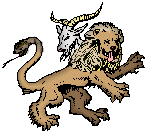
|
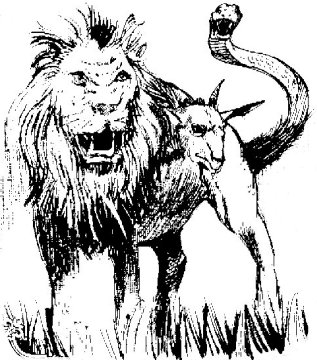
She was of divine
race, not of men, in the fore part a lion, in the hinder a
serpent, and in the middle a goat, breathing forth in terrible
manner the force of blazing fire. And Bellerophon slew her,
trusting the signs of the gods. -- Homer, Iliad 6.181
The Chimaera who breathed raging fire, a creature fearful,
great, swift footed and strong, who had three heads, one of
grim-eyed lion, another of a goat, and another of a serpent. In
her forepart she was a lion; in her hinderpart a dragon; and in
her middle part, a goat, breathing forth a fearful blast of
blazing fire. Her did Pegasus and noble Bellerophon slay. --
Hesiod, Theogony 319
The Chimaera was a fire-breathing she-goat
with the head of a lion, the body of a goat and a serpent's
(or dragon's) tail. This unlikely beast was the product of a union between
arguably the two most hideous monsters found in mythology,
Typhon and Echidna.
Echidna bore a particularly dreadful brood to Typhon -- along with
the Chimaera, the two of them produced Cerberus,
the three-headed hound of Hades; Orthrus,
the two-headed hound of Geryon; the Sphinx,
who had a woman's head, lion's body, serpent's tail, and eagle's
wings; and the Hydra, a multi-headed water
serpent. The Chimaera and her siblings comprised some of the
most feared monsters in Greek mythology.
(It should be noted that in some versions of the Sphinx story,
it is suggested that its parents were the Chimaera and Orthrus.
For a full list of the offspring of
Echidna and Typhon
go here.)
The chimaera's most fearsome weapon was her ability to breathe
and spew out fire. This, combined with her lion's strength,
goat's cunning and snake's venom, made her nearly invincible
This dreaded monster took up residence in a place called Lycia
and caused great havoc, killing and terrorizing all the
neighboring area. In due time, the hero called Bellerophon,
riding the winged horse Pegasus, challenged this beast, which up
until then had been considered unbeatable.
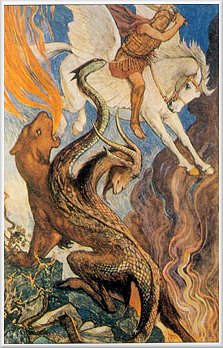
Illustration from Tanglewood Tales, c. 1920
Flying above the Chimaera on Pegasus,
Bellerophon rained down arrows on the creature, with little
effect - the beast was too strong and threatened to overwhelm
the hero with its flaming breath. Bellerophon then attached a
lump of lead to the point of his spear and thrust it between the
Chimaera's jaws. The creature's fiery breath melted the lead,
which trickled down its throat, burning its insides and
instantly killing it.
After overcoming the Chimaera, Bellerophon defeated the
neighboring enemies, including the fierce nation of women
warriors called the Amazons, and eventually became the champion
of Lycia. However, he was doomed to a bad ending, as you'll see
when you check out the
Bellerophon page...
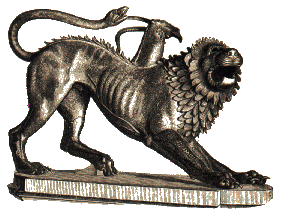
The Chimaera of Arezzo
The Chimaera of Arezzo is a bronze statue which was found in
Arezzo, Italy, in the year 1553. It is of Etruscan origin,
probably from 5th century BC, and it's one of the most beautiful
existing examples of ancient mythological art. It is presently
housed at the Archeological museum in Firenze, Italy.
from Nathaniel Hawthorne,
"A Wonder-Book for Girls and Boys", 1852
In a certain country of Asia, a terrible monster, called a
Chimaera, had made its appearance, and was doing more mischief
than could be talked about between now and sunset. According to
the best accounts which I have been able to obtain, this
Chimaera was nearly, if not quite, the ugliest and most
poisonous creature, and the strangest and unaccountablest, and
the hardest to fight with, and the most difficult to run away
from, that ever came out of the earth's inside. It had a tail
like a boa-constrictor; its body was like I do not care what;
and it had three separate heads, one of which was a lion's, the
second a goat's, and the third an abominably great snake's. And
a hot blast of fire came flaming out of each of its three
mouths! Being an earthly monster, I doubt whether it had any
wings; but, wings or no, it ran like a goat and a lion, and
wriggled along like a serpent, and thus contrived to make about
as much speed as all the three together.
from Pseudo-Apollodorus, Library 1.151
It had the fore part of a lion, the tail of a dragon, and
its third head, the middle one, was that of a goat, through
which it belched fire. And it devastated the country and harried
the cattle; for it was a single creature with the power of three
beasts. It is said, too, that this Chimera was bred by
Amisodarus, as Homer affirms, or that it was begotten by Typhon
on Echidna, as Hesiod relates. So Bellerophon mounted his winged
steed Pegasus, offspring of Medusa and Poseidon, and soaring on
high shot down the Chimera from above.
The Chimaera was a creature filled with hate and malice. She was
a beast bred by two of the most dangerous and evil beings in
mythology, so she was designed to only kill and destroy.
As a fire-breathing beast, the
chimera symbolizes the uncontrollable and destructive forces of
nature.
The Chimaera myth is about the victory of good over evil. It
teaches us that even if falsely accused and punished, as
Bellerophon was, you can always prevail and be rewarded. The
hero's courage and nobility earned him the hand of a princess
and much more.
Today we call all mythical or fictional monsters, made up of
hybrid parts from more than one animal, a Chimaera. These wildly
imaginative, implausible or dazzling beasts include the Sphinx, jackalope, manticore, griffin and hippogriff, among others.
A figment of imagination is often called a Chimaera.
The British and Europeans prefer the Chimaera spelling,
while in North America she is spelled as Chimera.
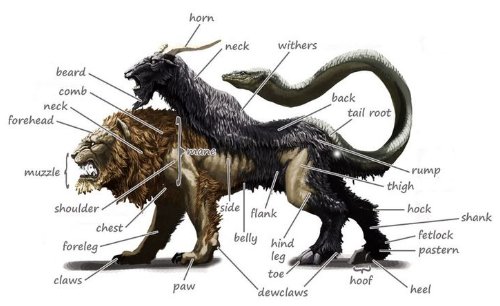
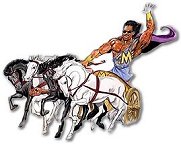
BACK HOME

|







